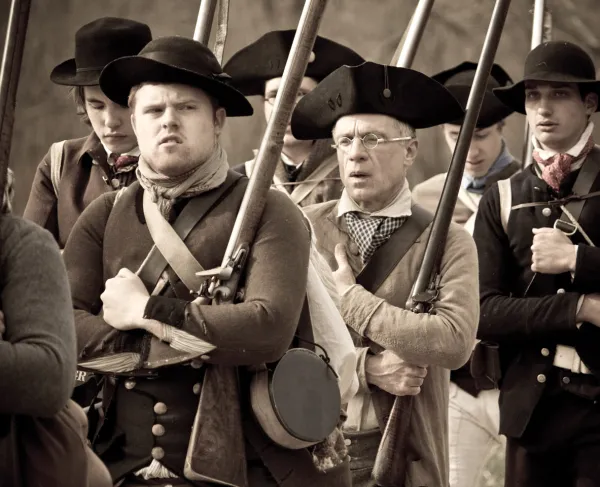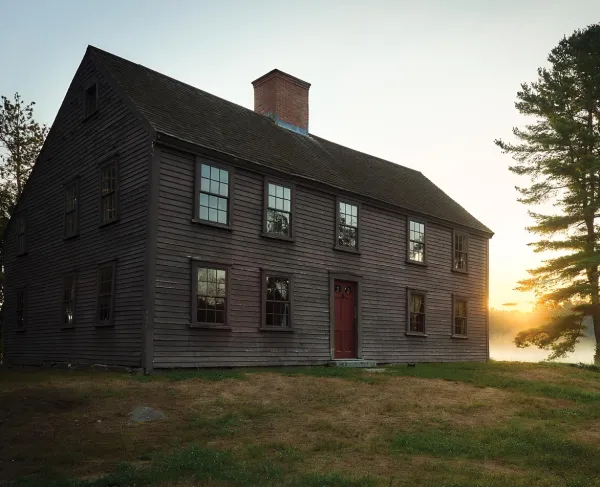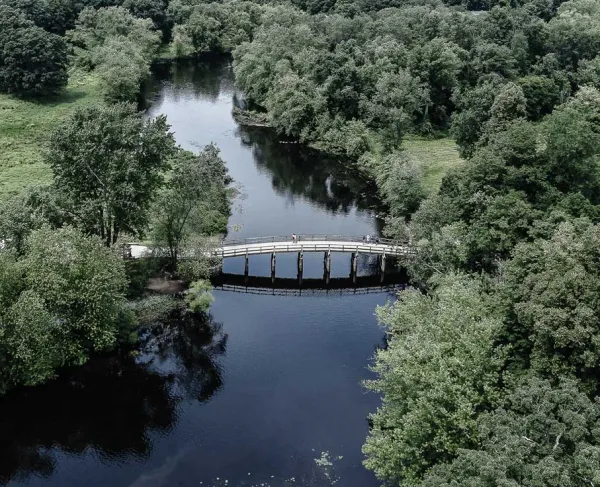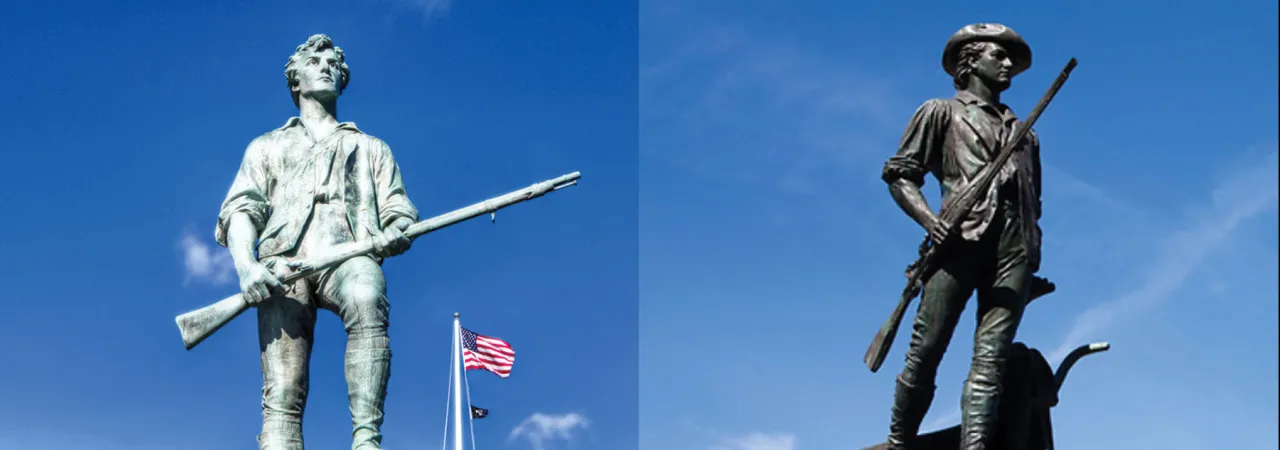
LEFT: The Lexington Minute Man statue by by Henry Hudson Kitson, Lexington, Mass.; RIGHT: Minute Man statue by by Daniel Chester French, Concord, Mass.
The Massachusetts hamlets of Lexington and Concord are inextricably linked in history to the first battle of the American Revolution on April 19, 1775. But in one respect, theirs can be a contentious rather than neighborly pairing.
For more than 200 years, folks in the town of Lexington, where colonial minute men shed the first blood in the American Revolution, have felt slighted by Concord’s attitude about the whole affair. You see, Concord, where other Patriots killed the first British soldiers at the North Bridge lays claim to being site of “the shot heard ’round the world.”
Wait, what? Were not the very first Patriot shots fired on Lexington’s Battle Green? Ineffective though they were, wouldn’t these be the shots that reverberated around the world; the shots that started an unlikely war for independence by an upstart colony of the British Empire?
The controversy had already been simmering for more than a decade before poet Ralph Waldo Emerson gave his hometown the nod in 1835 with the iconic lines in his “Concord Hymn:”
“Here once the embattled farmers stood, And fired the shot heard ’round the world.”
It all started in 1824, when the Revolutionary War hero Marquis de Lafayette visited the towns that form the cradle of American liberty. Lexington was infuriated when Concord took more credit than it thought due. At the time, there was a question whether any militia on Lexington Green even fired their weapons at all. Whereas at the North Bridge, there was no question: They responded to a British volley with one of their own, killing the first redcoats to fall in the war. It was at the North Bridge where the Patriots put up the “first forcible resistance,” folks in Concord asserted, and it was there where war really began.
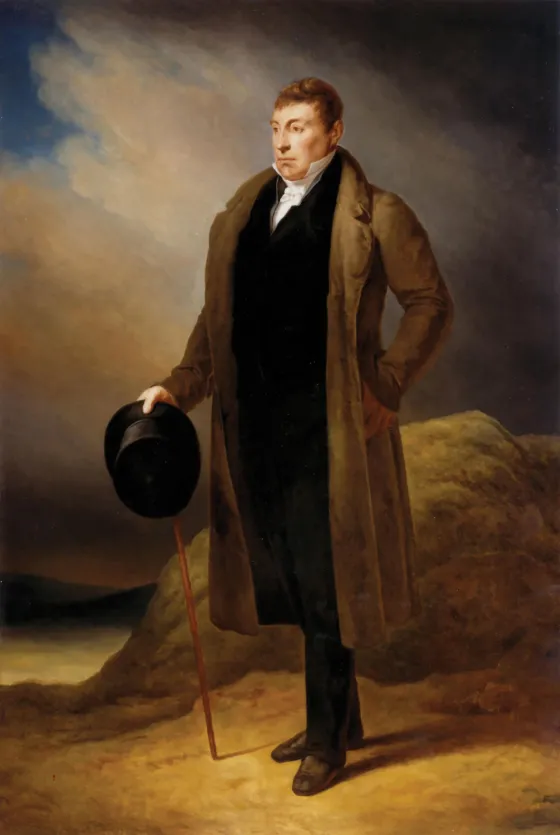
This infuriated their Lexington neighbors, and in 1825 the Lexington Town Meeting created a committee “strictly aimed at the truth” to ascertain the facts about the April 19 affair. It published a 46-page booklet by Elias Phinney, History of the Battle of Lexington: On the Morning of the 19th April, 1775.
“Those who have undertaken to relate the events of that day have omitted many important facts and circumstances, the tendency of which has been to diminish, in the publick estimation, the importance to the country of the stand made by the militia of Lexington on that morning,” the preface reads. In fact, it was on Lexington Green where their “fellow townsmen … boldly dared to begin the bloody conflict for independence…”
Eleven years later, the Concord Battle Monument Committee asked Emerson to write a poem for the dedication of an obelisk monument at the North Bridge. He lived in Concord, and his father and grandfather had witnessed the fighting. Emerson’s words added fuel to the controversy, as did the monument, which bears the words, “Here on the 19th of April 1775 was made the first forcible resistance to British aggression….” The dispute heated up again in 1894, when a petition was put before the Massachusetts Legislature requesting that April 19 be designated “Lexington Day.” That was quickly followed by a petition asking the legislature to anoint the famous day as “Concord Day.” The state compromised with “Patriots Day.”
It doesn’t help that the whole matter is riddled with uncertainties and inconsistencies. The first shot of the Revolution was fired at Lexington, to be sure, but it remains uncertain to this day whether it came from a British gun or a Patriot weapon — even whether it was intended or accidental. In the devastating British volleys that followed, eight Patriots were killed and 10 wounded. But several Patriots are on record as saying they fired their weapons at the British, and at least one redcoat was wounded. Resistance was scant, but not wholly absent.
At Concord, it was not a single shot “heard ’round the world,” but rather a volley from a handful of Patriots at or near the front of a two-line column at the head of the North Bridge. It came in response to a British volley that killed two Patriots and wounded four. This return fire killed three British soldiers, wounded nine and forced the redcoats to retreat.
However, when it comes to the amount of “forcible resistance” that day, then neither town ranks first. After the clashes at Lexington and Concord, the Patriots savaged the British forces during their retreat back to Boston, and by day’s end, the British had suffered more than 300 casualties, including some 73 killed. The colonists suffered about 93 casualties, including 49 dead.
Historian A. Michael Ruderman argues that the fighting in and around Menotomy (now Arlington) during the British retreat was the most significant action of April 19, writing: “Battle Green was an accident. Concord Bridge, a skirmish. But in the most brutal and deadly warfare of April 19, 1775, nearly 6,000 combatants fought hand to hand and house to house, the length and breadth of Menotomy.”
Today, both Concord and Lexington have Minute Man statues. Concord erected its statue in 1875 on the 100th anniversary of the battle, and its base includes the first stanza of Emerson’s poem. Lexington erected its Minute Man statue at the eastern point of the triangular Battle Green in 1900. And on the Green, at the place where the militia of Lexington formed their line, the town placed a rock memorial with a famous command that may or may not have been said by their leader, Captain John Parker: “Stand your ground. Don’t fire unless fired upon, but if they mean to have a war, let it begin here.”
The dispute lingers on, and as the famous phrase is invoked during this anniversary period, it is often done without any understanding of the complicated legacy and historiography it implies.
Related Battles
93
300
